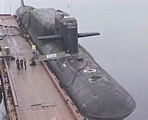Nuclear Weapons Reassert Russian Might, Sort Of
 A new review of Russian nuclear forces published in the Bulletin of the Atomic Scientists says that the Kremlin appears to be attempting to reassert its nuclear strength after years of decline in order to underscore Russia’s status as a powerful nation. Large-scale exercises have been reinstated and modernizations of nuclear forces continue with reports about a new maneuverable warhead and the mobile version of the SS-27 (Topol-M) expected to become operational later this year.
A new review of Russian nuclear forces published in the Bulletin of the Atomic Scientists says that the Kremlin appears to be attempting to reassert its nuclear strength after years of decline in order to underscore Russia’s status as a powerful nation. Large-scale exercises have been reinstated and modernizations of nuclear forces continue with reports about a new maneuverable warhead and the mobile version of the SS-27 (Topol-M) expected to become operational later this year.
Yet the reassertion is done with fewer strategic warheads than at any time since the mid-1970s, approximately 3,500 operational strategic warheads. The number of operational non-strategic nuclear weapons has been cut by more than half to approximately 2,300 warheads.
Moreover, during 2005, Russia’s 12 nuclear ballistic missile submarines only conducted three deterrent patrols. This is a slightly better performance than in 2002 when no patrols were made, but a far cry from the 1980s when Soviet ballistic missile submarines conducted 50-100 deterrent patrols each year.
Article: Russian Nuclear Forces, 2006
Background: Russian Submarine Patrols
Nuclear weapons budgeting is like agreeing to buying a house without knowing the sales price, the mortgage rate, or the monthly payment.
The United States Air Force has forward deployed about one-third of its B-2 stealth bombers to Diego Garcia, or about half the B-2s considered fully operational at any given time.
Over the past year, the campaign to abolish nuclear weapons has experienced numerous wins that were celebrated at the Meeting of State Parties.
China is NOT a nuclear “peer” of the United States, as some contend.
China’s total number of approximately 600 warheads constitutes only a small portion of the United States’ estimated stockpile of 3,700 warheads.